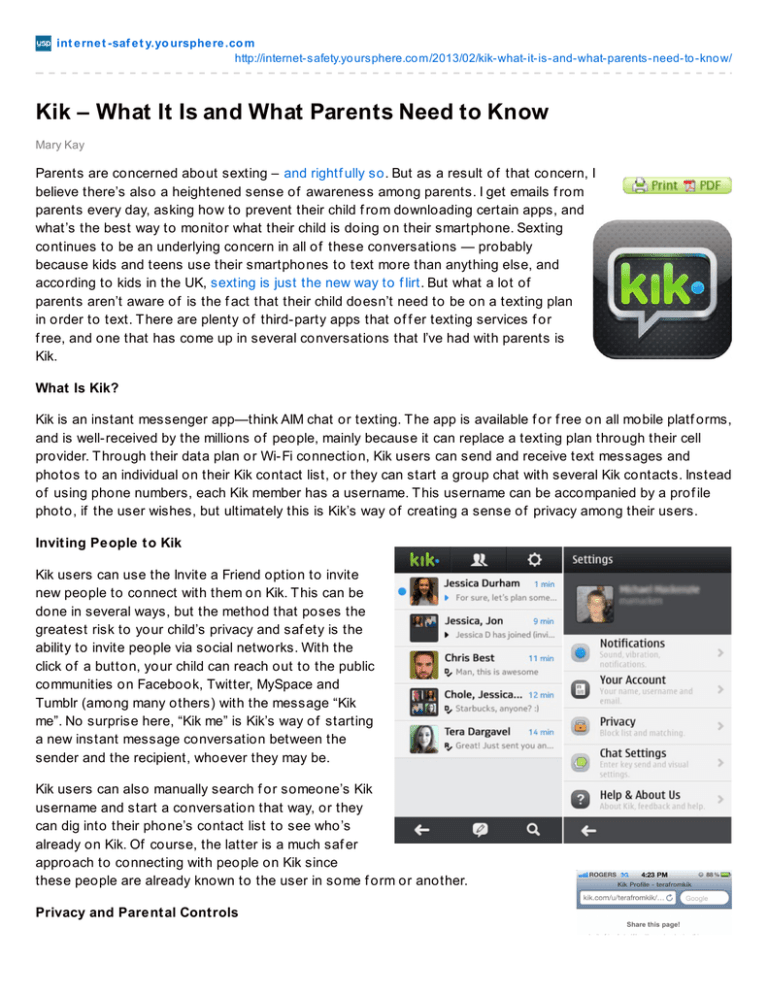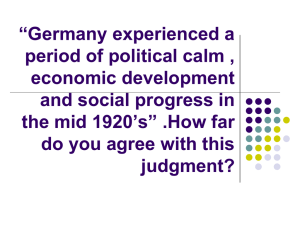Kik – What It Is and What Parents Need to...
advertisement

int e rne t -saf e t y.yo ursphe re .co m http://internet-safety.yo ursphere.co m/2013/02/kik-what-it-is-and-what-parents-need-to -kno w/ Kik – What It Is and What Parents Need to Know Mary Kay Parents are concerned about sexting – and rightf ully so. But as a result of that concern, I believe there’s also a heightened sense of awareness among parents. I get emails f rom parents every day, asking how to prevent their child f rom downloading certain apps, and what’s the best way to monitor what their child is doing on their smartphone. Sexting continues to be an underlying concern in all of these conversations — probably because kids and teens use their smartphones to text more than anything else, and according to kids in the UK, sexting is just the new way to f lirt. But what a lot of parents aren’t aware of is the f act that their child doesn’t need to be on a texting plan in order to text. T here are plenty of third-party apps that of f er texting services f or f ree, and one that has come up in several conversations that I’ve had with parents is Kik. What Is Kik? Kik is an instant messenger app—think AIM chat or texting. T he app is available f or f ree on all mobile platf orms, and is well-received by the millions of people, mainly because it can replace a texting plan through their cell provider. T hrough their data plan or Wi-Fi connection, Kik users can send and receive text messages and photos to an individual on their Kik contact list, or they can start a group chat with several Kik contacts. Instead of using phone numbers, each Kik member has a username. T his username can be accompanied by a prof ile photo, if the user wishes, but ultimately this is Kik’s way of creating a sense of privacy among their users. Inviting People to Kik Kik users can use the Invite a Friend option to invite new people to connect with them on Kik. T his can be done in several ways, but the method that poses the greatest risk to your child’s privacy and saf ety is the ability to invite people via social networks. With the click of a button, your child can reach out to the public communities on Facebook, Twitter, MySpace and Tumblr (among many others) with the message “Kik me”. No surprise here, “Kik me” is Kik’s way of starting a new instant message conversation between the sender and the recipient, whoever they may be. Kik users can also manually search f or someone’s Kik username and start a conversation that way, or they can dig into their phone’s contact list to see who’s already on Kik. Of course, the latter is a much saf er approach to connecting with people on Kik since these people are already known to the user in some f orm or another. Privacy and Parental Controls T hough Kik makes it easy to block other Kik users and ignore message notif ications f rom new people, they of f er zero parental controls, leaving it up to the child or teen to set these privacy settings on their own. Another Kik saf ety concern that you should be aware of , and this is credited to Michael Sheehan’s blog titled “Parents Beware: Instagram & Kik Messenger Are a Dangerous Combination & What Social Dangers to Check For”, is the f act that kids and teens are sharing their Kik username on public social networks, like Instagram, through comments and prof iles. As you can imagine, doing this opens the door to unwanted solicitations f rom Internet trolls, “pervs” and cyberbullies. In Michael’s case, his daughter’s f riend received a request to chat on Kik via Instagram and the next thing she knew she was being asked to send naked photos of herself . ——————————T he reason I wrote this piece wasn’t to bash Kik or to tell you that it’s an unsaf e app f or your child or teen; whether you f eel it’s saf e enough is entirely up to you and the maturity level of your child. But just like with any app or website that isn’t specif ically created f or children (and thus COPPA compliant), the saf ety and privacy risks tend to be more prevalent. With that being said, if your child is 12 or younger, they shouldn’t be using Kik at all. If your 13 or older teen pref ers to use Kik instead of texting, and you’re saving some money in the process, you don’t need to delete the app f rom their phone, just have a very serious conversation with them about the saf ety risks involved with sharing their Kik username in public social networks and f orums. While you’re at it, take f ive minutes to make sure they’re using the privacy settings. T he Internet will never be a totally “saf e place” f or our children, so we as parents have to remain vigilant and educated in order to take what we learn and pass it on to our kids.







